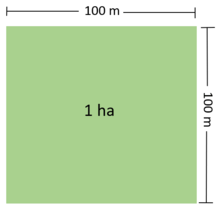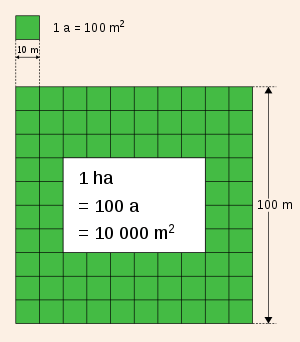Hectare
The hectare (/ˈhɛktɛər, -tɑːr/; SI symbol: ha) is a non-SI metric unit of area equal to a square with 100-metre sides (1 hm2), or 10,000 m2, and is primarily used in the measurement of land. There are 100 hectares in one square kilometre. An acre is about 0.405 hectare and one hectare contains about 2.47 acres.
| hectare | |
|---|---|
 A visualization of one hectare | |
| General information | |
| Unit system | Non-SI unit accepted for use with SI |
| Unit of | Area |
| Symbol | ha |
| Conversions | |
| 1 ha in ... | ... is equal to ... |
| SI base units: | 104 m2 |
| Imperial and US customary units | 11,960 sq yd; 2.4711 acres |
In 1795, when the metric system was introduced, the are was defined as 100 square metres and the hectare ("hecto-" + "are") was thus 100 ares or 1⁄100 km2 (10,000 square metres). When the metric system was further rationalised in 1960, resulting in the International System of Units (SI), the are was not included as a recognised unit. The hectare, however, remains as a non-SI unit accepted for use with the SI and whose use is "expected to continue indefinitely". Though the dekare/decare daa (1,000 m2) and are a (100 m2) are not officially "accepted for use", they are still used in some contexts.
Description
| Unit | SI |
|---|---|
| 1 ca | 1 m2 |
| 1 a | 100 m2 |
| 1 ha | 10,000 m2 |
| 100 ha | 1,000,000 m2 1 km2 |
| non-SI comparisons | |
| non-SI | metric |
| 0.3861 sq mi | 1 km2 |
| 2.471 acre | 1 ha |
| 107,639 sq ft | 1 ha |
| 1 sq mi | 259.0 ha |
| 1 acre | 0.4047 ha |

The hectare (/ˈhɛktɛər, -tɑːr/[2]), although not a unit of SI, is the only named unit of area that is accepted for use with SI units.[3] The name was coined in French, from the Latin ārea.[4] In practice the hectare is fully derived from the SI, being equivalent to a square hectometre. It is widely used throughout the world for the measurement of large areas of land,[5] and it is the legal unit of measure in domains concerned with land ownership, planning, and management, including law (land deeds), agriculture, forestry, and town planning throughout the European Union[6] and Australia (since 1970)[7][8]. However the United Kingdom,[9] United States, Burma,[10][11] and to some extent Canada use the acre instead.
Some countries that underwent a general conversion from traditional measurements to metric measurements (e.g. Canada) required a resurvey when units of measure in legal descriptions relating to land were converted to metric units. Others, such as South Africa, published conversion factors which were to be used particularly "when preparing consolidation diagrams by compilation".[12]
In many countries, metrication redefined or clarified existing measures in terms of metric units. The following legacy units of area have been redefined as being equal to one hectare:[13]
History
The metric system of measurement was first given a legal basis in 1795 by the French Revolutionary government. The law of 18 Germinal, Year III (7 April 1795) defined five units of measure:[17]
- The metre for length
- The are (100 m2) for area [of land]
- The stère (1 m3) for volume of stacked firewood[18]
- The litre (1 dm3) for volumes of liquid
- The gram for mass
In 1960, when the metric system was updated as the International System of Units (SI), the are did not receive international recognition. The International Committee for Weights and Measures (CIPM) makes no mention of the are in the current (2006) definition of the SI, but classifies the hectare as a "Non-SI unit accepted for use with the International System of Units".[19]
In 1972, the European Economic Community (EEC) passed directive 71/354/EEC,[20] which catalogued the units of measure that might be used within the Community. The units that were catalogued replicated the recommendations of the CGPM, supplemented by a few other units including the are (and implicitly the hectare) whose use was limited to the measurement of land.
Unit family

The names centiare, deciare, decare and hectare are derived by adding the standard metric prefixes to the original base unit of area, the are.
Decimilliare
The decimilliare (sometimes seen in cadastre area evaluation of real estate plots) is 1⁄10,000 are or one square decimetre.[21]
Deciare
The deciare (rarely used) is ten square metres.[24]
Are
The are (/ɑːr/[25] or /ɛər/[26]) is a unit of area, equal to 100 square metres (10 m × 10 m), used for measuring land area. It was defined by older forms of the metric system, but is now outside the modern International System of Units (SI).[27] It is still commonly used in speech to measure real estate, in particular in Indonesia, India, and in various European countries.
In Russian and some other languages of the former Soviet Union, the are is called sotka (Russian: сотка: 'a hundred', i.e. 100 m2 or 1⁄100 hectare). It is used to describe the size of suburban dacha or allotment garden plots or small city parks where the hectare would be too large.
Decare
The decare or dekare (/ˈdɛkɑːr, -ɛər/) is derived from deca and are, and is equal to 10 ares or 1000 square metres. It is used in Norway[28] and in the former Ottoman areas of the Middle East and the Balkans (Bulgaria)[29] as a measure of land area. Instead of the name "decare", the names of traditional land measures are usually used, redefined as one decare:
Conversions
| Unit name | Symbol | Multiple of preceding unit |
Fraction of succeeding unit |
SI equivalents | Imperial/U.S. customary equivalents |
|---|---|---|---|---|---|
| centiare | ca | 0.1 da | 1 m2 | 10.7639 sq ft | |
| deciare | da | 10 ca | 0.1 a | 10 m2 | 11.9599 sq yd |
| are | a[32] | 10 da | 0.1 daa | 100 m2 | 3.95369 perches |
| decare | daa | 10 a | 0.1 ha | 1000 m2 | 0.98842 roods |
| hectare | ha[5] | 10 daa | 0.01 km2 | 10000 m2 | about 2.4710538 acres |
| square kilometre | km2 | 100 ha | 1000000 m2 | 0.38610 sq mi |
The most commonly used units are in bold.
One hectare is also equivalent to:
- 1 square hectometre
- 15 mǔ or 0.15 qǐng[33]
- 10 dunam or dönüm (Middle East)[34]
- 10 stremmata (Greece)
- 6.25 rai (Thailand)[35]
- approximately 1.008 chō (Japan)
- approximately 2.381 feddan (Egypt)
References
- "Department for Environment, Food and Rural Affairs, and Rural Payments Agency; The Delays in Administering the 2005 Single Payment Scheme in England" (PDF). National Audit Office. 18 October 2006. p. 27.
- "hectare". Oxford Dictionaries. Retrieved 24 December 2010.
- Bureau international des poids et mesures (2006). "The International System of Units (SI)" (PDF). 8th ed. Retrieved 13 February 2008. Cite journal requires
|journal=(help) Chapter 5. - Oxford English Dictionary, 1st edition s.v.
- BIPM (2014). "SI Brochure, Table 6". Retrieved 17 November 2014.
- The Council of the European Communities (27 May 2009). "Council Directive 80/181/EEC of 20 December 1979 on the approximation of the laws of the Member States relating to Unit of measurement and on the repeal of Directive 71/354/EEC". Retrieved 29 January 2010.
- Commonwealth of Australia (1970). "Metric Conversion Act". Retrieved 14 August 2020.
- Metric Pioneer (2020). "Metric Pioneer". Retrieved 14 August 2020.
- "Weights and Measures Act 1985" (PDF). British Government. 1985. Retrieved 17 December 2016.
- "Appendix G – Weights and Measures". The World Factbook. CIA. 2006. Retrieved 8 August 2006.
- MYA/01/008 Agriculture Sectore Review, Working Paper No. 6 – Agroindustry in Myanmar Archived 15 May 2013 at the Wayback Machine
- "Instructions for the Conversions of Areas to Metric". Law Society of South Africa. November 2007. Retrieved 21 January 2011.
- Britannica, unit of measurement, accessed 30 October 2009
- Chisholm, Hugh (1911). The Encyclopædia britannica: a dictionary of arts, sciences, literature and general information. The Encyclopædia britannica company. p. 442. Retrieved 15 March 2012.
- Oscar van Vlijmen (11 September 2006). "Oppervlakte" [Area]. Eenheden, constanten en conversies [Units, constants and conversion] (in Dutch). Retrieved 15 January 2011.
- Jacob de Gelder (1824). Allereerste Gronden der Cijferkunst [Introduction to Numeracy] (in Dutch). 's-Gravenhage and Amsterdam: de Gebroeders van Cleef. p. 156. Retrieved 19 September 2012.
- "La loi du 18 Germinal an 3 " la mesure [républicaine] de superficie pour les terrains, égale à un carré de dix mètres de côté »" [The law of 18 Germanial year 3 "The [Republican] measure of land area equivalent to a ten-metre square"] (in French). Le CIV (Centre d'Instruction de Vilgénis) – Forum des Anciens. Retrieved 2 March 2010.
- Thierry Thomasset. "Le stère" (PDF). Tout sur les unités de mesure [All the units of measure] (in French). Université de Technologie de Compiègne. Archived from the original (PDF) on 21 July 2011. Retrieved 21 March 2011.
- "SI brochure (Chapter 4; Table 6)". International Bureau of Weights and Measures. 2006. Archived from the original on 1 October 2009. Retrieved 5 March 2010.
- "Council Directive of 18 October 1971 on the approximation of laws of the member states relating to units of measurement, (71/354/EEC)". Retrieved 7 February 2009.
- Robinson, Horatio Nelson; Fish, Daniel W. (1858). Robinson's Progressive Practical Arithmetic: Containing the Theory of Numbers in Connection with Concise Analytic and Synthetic Methods of Solution, and Designed as a Complete Text-book on this Science for Common Schools and Academies. Ivison, Blakeman, Taylor. p. 363.
- "centiare". Dictionary.com. Dictionary.com, LLC. Retrieved 16 October 2019.
- "centiare". Collins Dictionary. Collins Publishers. Retrieved 16 October 2019.
- "deciare". Merriam Webster Dictionary. Merriam-Webster, Incorporated. Retrieved 16 October 2019.
- "are". Oxford Dictionaries. Retrieved 24 December 2010.
- "are – definition. American English definition of are by Macmillan Dictionary". Macmillandictionary.com. Retrieved 20 May 2012.
- "SI brochure (8th edition)". BIPM. March 2006.
- "Decrease in total grain yield". Grain and oil seeds, area and production, 2002. Statistics Norway. Retrieved 16 November 2010.
- "Market of agricultural land in Bulgaria". BNR Radio Bulgaria. 5 October 2010. Archived from the original on 22 October 2010. Retrieved 16 November 2010.
- Λεξικό της κοινής Νεοελληνικής (Dictionary of Modern Greek), Ινστιτούτο Νεοελληνικών Σπουδών, Θεσσαλονίκη, 1998. ISBN 960-231-085-5
- El-Eini, Roza I.M. (2006). "Currency and Measures". Mandated landscape: British imperial rule in Palestine, 1929–1948. Routledge. p. xxiii. ISBN 978-0-7146-5426-3. Retrieved 5 May 2009.
- BS350:Part 1:1974 Conversion factors and tables Part 1. Basis of tables. Conversion factors. British Standards Institution. 1974. p. 7.
- "Chinese Measurements – Units of Area". On-line Chinese Tools. Retrieved 24 December 2010.
- François Cardarelli (2003). Encyclopaedia of scientific units, weights, and measures: their SI equivalences and origins. London, Berlin and Heidelberg: Springer Verlag. p. 97. ISBN 1-85233-682-X. Retrieved 29 March 2011.
metrication malta.
- "Thailand Property Conversion". Siam Legal (Thailand) Co., Ltd. Retrieved 24 December 2010.
External links
| Wikimedia Commons has media related to Hectare. |
| Look up hectare in Wiktionary, the free dictionary. |
